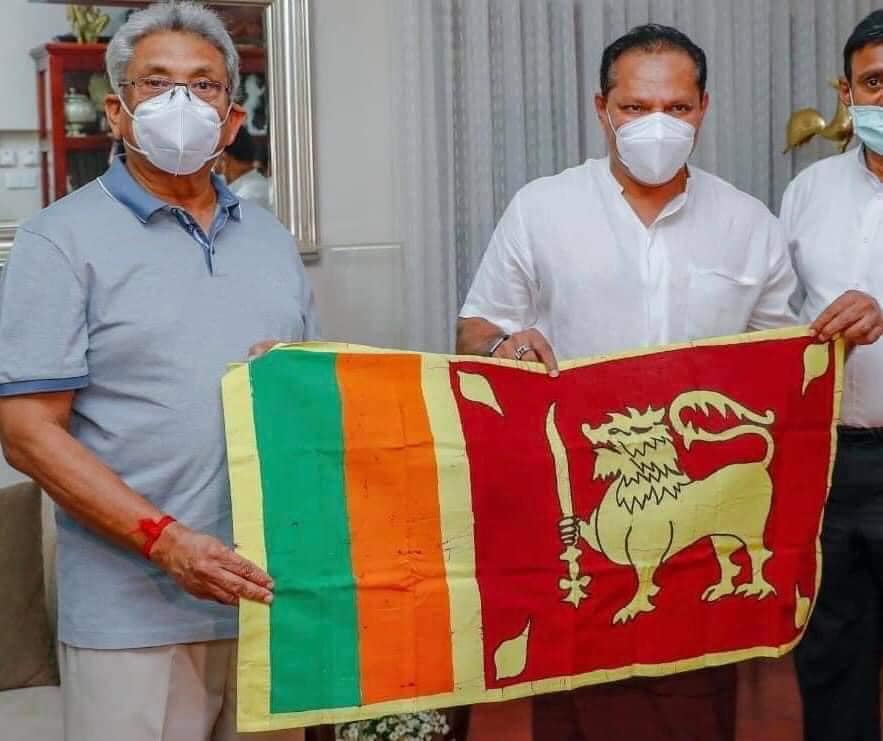.jpeg)
Photo credit: Shehara De Silva (via @Charindra_chan)
The first and most important thing to understand about the Sri Lankan flag is that every version of the lion flag is, definitionally, racist and fascist in symbolism, including the official one. It was intentionally designed that way, by committee. The proportions of the “majority box” to the “minority stripes” (5:1:1) were determined by population ratios which were determined by:
1. racialized census categories introduced by the British Empire in the preceding few decades and enthusiastically taken up by the burgeoning Sinhala-supremacist postcolony, which divided the Tamil-speaking population into sub-races by religion but not the Sinhala-speaking population and
2. the chaos introduced by the then-contemporary Citizenship Act, which made a massive proportion of the Tamil-speaking population stateless and disenfranchised.
The clear intention of the national flag’s design was to centre this Sinhala supremacism and marginalize minorities, represent them as barely-tolerated outsiders at best. Contemporary dissent (e.g. Senator Nadesan) makes it clear that this was not an analysis that was somehow beyond them. It was pointed out, very explicitly, and ignored.
The reason the flag is fascist in addition to being racist is (in addition to its reliance on racialization, the glorification of the dominant “race”, and the warlike symbolism, all fascist standbys) is because this lion also came accompanied by an entirely fictional mytho-history concocted by E.W. Perera and D.R. Wijewardena. The story is that the lion flag represents a return to a mythic precolonial history, which it does not. Purported centuries-old or millennia-old connections to Kandyan flags and Dutugemunu &c. are nonsense: fantastical worldbuilding as background for nation-building. Flags of the precolonial world did not serve the same purposes as nation-state era flags, any more than “Sinhalese” represented a racial designation rather than a political designation in the era before colonial racialization. They did not carry the same meanings, and the lion had no special place: you’ll find plenty of other animals wandering about in flags and other precolonial iconography, a whole zoo of them. The idea that there could be any sort of rebooted franchise, a meaningful remake, a direct connection between a symbol and its meaning before and after over two hundred years of colonial reprogramming and brainwashing is laughable.
Perera, an epic fantasy writer before his time, simply invented a brief and outsourced the design to a London designer (Southwood & Co. in Regent Street), presumably some white guy, who knocked off a generic European heraldic lion passant with finials and called it a day. At best, they were more likely influenced by British and Dutch colonial flags of the preceding generation than anything else, but seeing as how Perera, Wijewardena et al. were already thoroughly brainwashed by colonial programming, this would have been perfectly acceptable to the Sinhala supremacist mindset. It was Britishness that the Sinhala elite wanted and envied, to finally become the white man, the colonizer, the master sir.
The specifics of the flag’s design clearly didn’t really matter to Perera or Wijewardena, in any case, given that they found whatever the designer came back with acceptable. One wonders if there were private rounds of feedback and redesign, but I suspect not. The details only matter if you give a shit. All they wanted was to put a lion on it. Their strategy of decolonization was merely to ensure above all that the “Sinhalese” inherited the colonial mantle of whiteness on the island. Whiteness exists to be the race that dominates other races—this is why “race” exists and why it was invented—and in the postcolony, at least in Sri Lanka and probably elsewhere too, the changing of the guard was not reflected by the deconstruction of this construct of race, but by its rigorous enforcement. The goal was not and never unity: such things are judged by what people do, not what people say, and the national flag is the perfect example. Taking the colonizer’s place, becoming the colonizer was the only ambition of decolonization-era Sinhala elites. And it remains true today, which is why the national flag now exists in multiple unofficial variations, each one making the flag’s true nature more explicit than the last.
The version of the flag seen in the tweet, meanwhile, is of particular interest because it actually has no history that I’m aware of: it is an entirely new thing under the sun. Even the alleged historic flag of Kandy had finials, not fig leaves, so this is not that. Besides, all legitimized versions of the flag have the lion holding the sword by the hilt, not by the blade. The only flag that I’ve seen before with that design is Dayasiri Jayasekera’s innovation from 2020.

At the time, this was seen as a simple, if ludicrous error, given that it apparently got all the way this moment without anybody noticing
Of course, this version of the flag has the minority stripes, so it too is not a match. The perahera flag cannot claim a history even two years old; it is freshly hatched, mere days in the making.
But the return of this blade-holding lion makes me think that this is perhaps not an error after all. Perhaps it is merely a catwhistle, a new icon chosen by fascist thought leaders as being more appropriate for contemporary Sinhala modernity, a self-harming lion, a bleeding lion that can’t stop cutting itself.
_____
This piece, which was reproduced with permission, was originally published on Vajra Chandrasekera's blog here.

